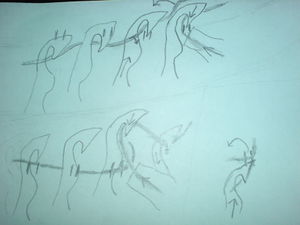Knitting Machine: Difference between revisions
m (Fixed a typo and remembered to sign a comment.) |
(Added update about the OpenKnit project. Note: link to Gerard's repo led to a 404 error at the time of editing.) |
||
| Line 2: | Line 2: | ||
==Linear Knitting Machines== | ==Linear Knitting Machines== | ||
These are best suited for producing garments with large surface areas, especially with chiefly rectangular surfaces. For example, scarves are easily made in one job, | These are best suited for producing garments with large surface areas, especially with chiefly rectangular surfaces. For example, scarves are easily made in one job, sections can be sewn together to produce sweaters, or complex digital patterns can even produce one such garment in a single run (see below). | ||
Thanks to the efforts of [http://www.knitic.com/ Knitic], who were [http://yearofopensource.net/the-wonderful-wooly-world-of-hacked-knitting-machines/ hacking on old floppy-disc-controlled Brother linear knitting machines], some [https://github.com/mcanet/knitic free software was created] to enable general programming of this type of machine. Since then, the [http://openknit.org/ OpenKnit] project has gone ahead and created a completely [https://github.com/g3rard/OpenKnit open hardware design for a mostly-3D-printable machine] ('''broken link!''' can someone please find another source for this design). | |||
<html> | <html> | ||
<iframe width="560" height="315" src="https://www.youtube.com/embed//GhnTSWMMtdU" frameborder="0" allowfullscreen></iframe> | <iframe width="560" height="315" src="https://www.youtube.com/embed//GhnTSWMMtdU" frameborder="0" allowfullscreen></iframe> | ||
<iframe src="//player.vimeo.com/video/86987828" width="500" height="281" frameborder="0" webkitallowfullscreen mozallowfullscreen allowfullscreen></iframe> | |||
</html> | </html> | ||
Revision as of 02:20, 24 October 2014
Knitting machines were developed throughout the 20th century in order to speed up what was otherwise a very time-consuming process for producing clothing. Initially they improved upon an operation ostentibly involving two knitting needles, by using moving carriages past a row of small moveable hooks, and then allowed for those pins to be selected by a computer program. Each step represented an order of magnitude decrease in human labour-time needed to make a given garment.
Linear Knitting Machines
These are best suited for producing garments with large surface areas, especially with chiefly rectangular surfaces. For example, scarves are easily made in one job, sections can be sewn together to produce sweaters, or complex digital patterns can even produce one such garment in a single run (see below).
Thanks to the efforts of Knitic, who were hacking on old floppy-disc-controlled Brother linear knitting machines, some free software was created to enable general programming of this type of machine. Since then, the OpenKnit project has gone ahead and created a completely open hardware design for a mostly-3D-printable machine (broken link! can someone please find another source for this design).
Circular Knitting Machines
These are more appropriate for producing garments that involve tube sections where a seam sewn along its length can cause discomfort, e.g. socks, stockings, winter hats and sleeves for other garments. Their utility, while arguably narrow, is very powerful since they can produce socks in minutes with a skilled operator, and socks/hosiery are generally the type of garments that wear out fastest.
Their theory of operation is relatively simple, but as far as I know there are no CNC designs in the public domain, although there is a lot of information to search through and many images of actual machines with long-expired patents.
While the 100-year-old steel machines look like they could be very difficult to replicate in a basic fab-lab due to their intricate construction, the existence of more recent 'toy'/'hobby' versions, constructed with chunky plastic, seems to indicate that this could be possible on your average RepRap Prusa-Mendel, so long as small size is not an initial requirement. Getting hold of one to take apart and reverse-engineer may be a good short-term goal. - Andy D
Product Ecology
| From | Uses | Creates | Enables |
|---|---|---|---|
|
Components
|
|
|
Links
Videos
